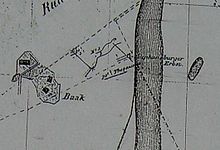Stephansburger Erbstollen
| Stephansburger Erbstollen | |||
|---|---|---|---|
| General information about the mine | |||
| Mouth hole | |||
| Information about the mining company | |||
| Start of operation | 1790 | ||
| End of operation | 1888 | ||
| Funded raw materials | |||
| Degradation of | Hard coal | ||
| Geographical location | |||
| Coordinates | 51 ° 24 '50 " N , 7 ° 10' 59" E | ||
|
|||
| Location | Winz-Baak | ||
| local community | Hattingen | ||
| District ( NUTS3 ) | Ennepe-Ruhr district | ||
| country | State of North Rhine-Westphalia | ||
| Country | Germany | ||
| District | Ruhr area | ||
The Stephansburger Erbstollen was a hard coal mine in the Winz-Baak district of Hattingen . It existed from 1790 to 1888. The tunnel was driven north from the Rauendahl . In 1867, 2,000 tons of hard coal were mined. After 1888 the rightful owner came to the United Dahlhauser Tiefbau colliery . The tunnel mouth hole is still preserved today, but walled up.
history

On July 12th, 1790 the trades of the Stephansburger Erbstollen received the right to drive an Erbstollen from the Ruhr valley to the north at the general award ceremony with the obligation to specially mute each seam . The tunnel was excavated directly from the bank of the Ruhr near the former Schepmann farm. The coal extracted could be loaded directly from the tunnel mouth hole into the Ruhraaken (towing ships). Since 1776, after the Ruhr was made navigable, the coal was transported on these barges to the main transshipment point Ruhrort .
In 1855 the tunnel was driven 120 Lachter (approx. 251 m) far and had passed through four coal seams . The mining took place to the left and right in tunnel wing towns . At that time, the eleven-man workforce produced 366 tons per year. Some of the coal coming out of the tunnel has meanwhile been brought to the coal mine near the Hattingen Ruhr Bridge on a newly built horse-drawn railway .
In 1867, 36,888 bushels (approximately 2000 tons) of coal were extracted from the tunnel . In 1888 the Erbstollen was still in operation. The Stephansburger Erbstollen still does its job today by draining the mountains above it. Below the towpath you can see how pit water flows from a thick pipe into the Ruhr.
swell
- ^ Volkshochschule Stadt Hattingen, board of the "Working Group on the History of Mining in the Hattinger Area" on site
literature
- Wilhelm Hermann, Gertrude Hermann: The old mines on the Ruhr. 4th edition, Verlag Karl Robert Langewiesche, successor Hans Köster KG, Königstein i. Taunus, 1994, ISBN 978-3-7845-6994-9


